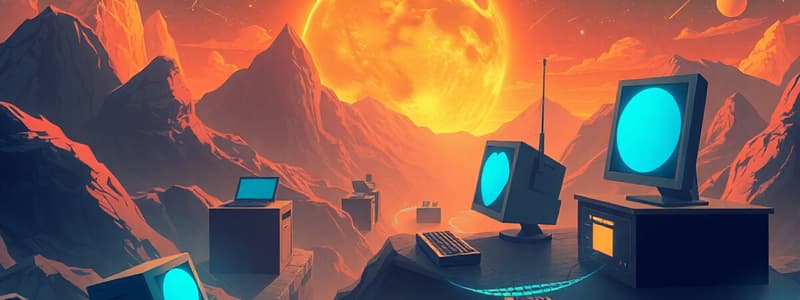Podcast
Questions and Answers
What is a computer?
What is a computer?
An electronic device that manipulates information, or data. It can store, retrieve, and process data.
Which of the following is a function of a computer? (Select all that apply)
Which of the following is a function of a computer? (Select all that apply)
- Cook food
- Type documents (correct)
- Send emails (correct)
- Play games (correct)
What is a vacuum tube used for?
What is a vacuum tube used for?
Controlling the flow of electronics in a vacuum.
What does ENIAC stand for?
What does ENIAC stand for?
The UNIVAC was the world's first commercially available electronic computer.
The UNIVAC was the world's first commercially available electronic computer.
What does a transistor do?
What does a transistor do?
What is the IBM 1401 known for?
What is the IBM 1401 known for?
What are integrated circuits in computers?
What are integrated circuits in computers?
The IBM System/360 was launched on April 7, 1964.
The IBM System/360 was launched on April 7, 1964.
What is the purpose of a microprocessor in a computer?
What is the purpose of a microprocessor in a computer?
What does Artificial Intelligence deal with?
What does Artificial Intelligence deal with?
What are the two kinds of software?
What are the two kinds of software?
Which of the following is an example of application software? (Select all that apply)
Which of the following is an example of application software? (Select all that apply)
What is the role of input devices in a computer?
What is the role of input devices in a computer?
What are output devices used for?
What are output devices used for?
Flashcards are hidden until you start studying
Study Notes
What is a Computer?
- An electronic device that processes data.
- Computers can store, retrieve, and process data.
- Used for various tasks: typing documents, sending emails, playing games, browsing the web, creating spreadsheets, presentations, and videos.
Generations of Computers
-
First Generation (1940s-1950s):
- Vacuum Tubes: Used for controlling the flow of electricity.
- ENIAC: Electronic Numerical Integrator and Computer, built by J. Presper Eckert and John V. Mauchly.
- General-purpose computer.
- Cumbersome and large, contained 18,000 vacuum tubes.
- UNIVAC: Universal Automatic Computer, the world's first commercially electronic computing device.
- Created by Eckert and Mauchly in 1947.
-
Second Generation (1950s-1960s):
- Transistors: Used for controlling the flow of electricity in devices as amplifiers or switches.
- IBM 1401: Changed perceptions of computers in businesses.
- Smaller, more affordable, and accessible to medium-sized companies and labs.
-
Third Generation (1960s-1970s):
- Integrated Circuits (ICs): Silicon chips containing transistors, resistors, etc.
- IBM System/360: Launched in 1964, designed for all types of users with one unified software-compatible architecture.
-
Fourth Generation (1970s-1980s):
- Microprocessors: One chip containing all circuits for arithmetic, logic, and control functions.
- IBM PC: Connected to televisions, allowing users to process text and play games.
-
Fifth Generation (1980s-Present):
- Artificial Intelligence (AI): Focuses on creating intelligent machines and behaviors.
- IBM Watson: Sparked interest in "machines that could think" and the potential applications of AI in business.
Five Types of Computers
- Personal Computers (PCs)
- Mainframes
- Supercomputers
- Minicomputers
- Workstations
Input, Output, and Memory Devices
- Input: Data or information entered into a computer for processing using input devices.
- Output: Processed information displayed through output devices.
- Memory Devices: Store data for future use.
Computer Software
- Software: Computer programs that provide instructions for the computer.
- System Software: Programs used by the computer hardware.
- Operating systems, device drivers, and utilities manage internal computer resources.
- Examples: Windows XP, Windows Vista.
- Application Software: Programs used by end-users to process data.
- Examples:
- Word Processing: MS Word
- Spreadsheet: MS Excel
- Presentation Graphics: MS PowerPoint
- Organizer: MS Outlook
- Database Management: Microsoft Access
- Desktop Publishing, Graphics, Video, Multimedia, Animation
- Examples:
- Connectivity Applications: Microsoft Internet Explorer or Netscape Navigator used for connecting to and browsing the internet.
Studying That Suits You
Use AI to generate personalized quizzes and flashcards to suit your learning preferences.




